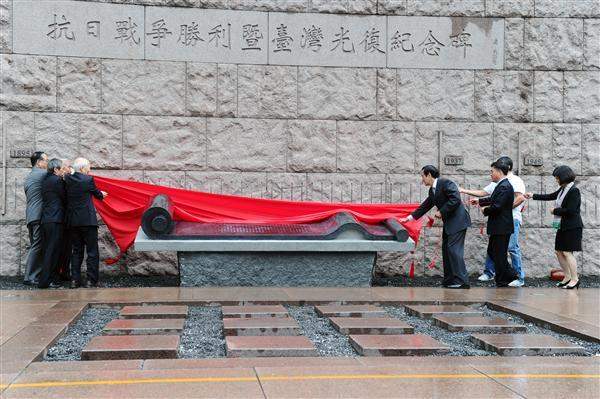News & activities
 News releases
News releases
October 25 is Taiwan’s Retrocession Day, which commemorates the day of Taiwan's retrocession to the ROC from Japan at the end of World War II. President Ma Ying-jeou in the morning unveiled a new addition to a memorial marking the event at Zhongshan Hall plaza in downtown Taipei. The memorial commemorates the sacrifices of Chinese patriots in the War of Resistance Against Japan (1937-1945). President Ma reiterated that the ROC is our nation and that Taiwan is our home. We are all Taiwanese and ROC citizens, he added.
In remarks delivered at the event, President Ma stated that this year marks the 66th anniversary of the ROC’s victory in the War of Resistance and Taiwan's retrocession. It was 66 years ago at this exact location, he said, that the ROC government accepted the surrender of Japanese forces. The ROC government in 1946 declared October 25 as Taiwan’s Retrocession Day and proclaimed the reinstatement of ROC nationality for the residents of Taiwan and Penghu, effective as of October 25, 1945. This showed that the government was not occupying Taiwan and Penghu in a time of war, but rather was exercising its sovereignty over these places, the president remarked.
President Ma furthermore noted that on December 9, 1941 the ROC government formally declared war against Japan, Germany, and Italy, and in the final portion of the declaration stated that all treaties, agreements, and contracts with Japan were annulled in light of the declaration of war. In 1943, he explained, the Cairo Declaration stated that "all the territories Japan has stolen from the Chinese, such as Manchuria, Formosa, and the Pescadores, shall be restored to the Republic of China." President Ma said that this clearly shows that one of the government's objectives in the War of Resistance was to recover Taiwan. On September 9, 1945, General He Yingqin (何應欽) in Nanjing accepted a surrender document from Japan’s Commander-in-Chief of the China Expeditionary Army Yasuji Okamura. This document clearly stated that Japan accepted the Potsdam Declaration, in which paragraph 8 stipulated that the terms of the Cairo Declaration shall be carried out. Furthermore, the ROC and Japan in 1952 signed the Treaty of Peace between the Republic of China and Japan, which reiterated the ROC citizenship of the people of Taiwan and Penghu. This series of legal and political activities confirmed the ROC's sovereignty over Taiwan, the president explained.
President Ma said that if the government at that time had not been there to accept the handover of Taiwan by Japan, the ROC might have ceased to exist after the Chinese Civil War (1927-1937; 1945-1949). And without the ROC, Taiwan might not have experienced the development it has seen over the past six-plus decades, and instead would have long ago fallen under communist rule. This, he indicated, shows that the ROC and Taiwan have long since fused into a single entity. Looking back at the past, President Ma said, the historical events that took place enabled the rebirth of the ROC in Taiwan, and turned Taiwan into a place to carry out the ideals of the nation's founding father Dr. Sun Yat-sen.
President Ma also mentioned that starting from 1950, the government began steadily implementing local self-rule and election of county magistrates and city mayors. Over the course of a long period of development and hard work, we have progressed to where there is no other ethnic Chinese society in the world that can match Taiwan's level of economic prosperity, democratic government, or social justice, he commented. President Ma said that we must cherish these achievements and express our deepest gratitude to our forefathers for their sacrifices. The president also remarked that the nation must continue to enhance its democracy, freedom, human rights, and rule of law, enabling even greater liberty and democracy to take root in Taiwan.
After completing his remarks, President Ma and Taipei City Mayor Hau Lung-bin (郝龍斌), along with descendants of people who died in the war against Japan, jointly unveiled the scroll with an inscription carved into it that chronicles the events of the war. The president then toured a special exhibition that marked the retrocession of Taiwan and showcased the evolution of its self-rule over the past century. The exhibition also details Taiwan's march over the decades toward democracy. The president and Mayor Hau then engaged in a mock vote to reflect Taiwan's democratic self-rule.



